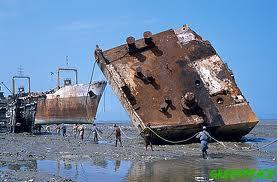Ship Breaking in India: Environmental and Occupational Hazard
India is becoming a graveyard for the dying ships. And so it is for the workers of the shipyards too. Shipbreaking is also environmentalists’ nightmare. Toxic materials, most of which are highly hazardous, are dumped in the ship-breaking yards of India. The most tragic part of the story is the fate of the workers who are facing fatal occupational hazards. Not to forget, India is one of the six surviving ship-breaking nations in the world, along with China, Bangladesh, Turkey, Pakistan and Myanmar.
Clemenceau, the French flagship carrier coming to Alang Ship breaking yard in Gujarat, has attracted worldwide attention. It was decommissioned from service many years ago and was harboured in the Toulon military harbour for the last seven years like a mammoth ghost frame of steel weighing about 26,000 tonnes. This ship is full of asbestos (around 40-50 tonnes), PCBs (polychlorinated biphenyls), TBT (tributyltin), lead, mercury and other toxic chemicals, which France and no other European countries are willing to or able to scrap due to expensive environmental costs.
Then why do the Government of France send it off to India to be broken in a scrap yard where impoverished workers are injured and die every day due to various occupational health hazards? It is no less ironic that an Indian company bought the ship for breaking, and the Union Government also supports it.
Asbestos, a leading contributor to pollution, is the main cause of the controversy. Though crocidolite asbestos, one of the six kinds of naturally occurring aluminium fibres, is banned in India, it can still be found in old insulation material and in old ships from other countries for dismantling in India. However, in the European Union, Chrysotile Asbestos has been classified as a Category-1 carcinogen. It has been responsible for over 2,00,000 deaths in the United States. A recent study shows in Western Europe alone, past asbestos exposure will cause a quarter of a million deaths from Mesothelioma (cancer) over the next thirty-five years. The number of lung cancer deaths caused by asbestos is at least equal to the number of Mesothelioma deaths.
Migrant workers dismantle the ships with their bare hands. Almost one out of every three workers suffers from cancer making ship-breaking one of the deadliest industries in the world. Even their sleeping quarters are not free from danger. Many are also injured or killed by suffocation or explosion related mishaps. The saddest part is that the workers are mostly temporary and are not covered under any labour benefits.
Generally, ships are broken on the sea coast, by the river-mouth. Hazardous materials mix up with cesspool, which carries the pollutants to the river water as well as in the sea. The soil and water of the surrounding area become heavily contaminated, threatening the marine ecosystem. One can easily find the garbage dump outside the dock, which consists of metal scraps, wastes, and persistent organic pollutants (POPs). The agricultural land and the health of adjoining village residents also suffer heavily. Ballast water, used to maintain the ship's balance while sailing, pollutes the coastal area with oil, biocides and heavy metals. After 25-30 years, ships end their sailing life. These ‘End of Life Vessels’ are sold and dismantled to recover the valuable steel. About 95% of the ship consists of steel. Annually, about 600-700 large sea vessels are brought to Asian countries for breaking them into scrap. In 2001, the total number of vessels (608) sold for scrap totalled steel of 28 million dwt. According to E.A. Gibson Shipbrokers, this marks a yearly growth of nearly 25%. Also, this non-recognised industry meets a large chunk of India’s steel demand.
On the other hand, the migrant labourers working in the ship breaking are not recognised by any labour laws. According to Dr. S K Dave of National Institute of Occupational Health Ahmedabad (NIOH), there is inadequate or no health infrastructure to look after the health related problems of these workers. Nor do we have a clear number of deaths due to occupational health hazards and asbestos-related deaths of the workers. These workers could be saved by following some simple industrial safety measures like using gloves, gas-masks and similar protective gears.
Decommissioned French aircraft carrier Clemenceau has passed through the Suez Canal now and heading towards Alang yard. The Supreme Court has already barred it from entering Indian territorial waters until experts had determined whether it was carrying hazardous waste. It has already created a ripple among the media people, politicians and the environmentalists of the country. This is really tragic that we are importing the hazardous toxic materials to our country for making others pollution free. Generally, we Indians love to remain in slumber keeping the eye open and do not awake until there is a big jolt. This is high time to protest against this hazardous practice and to secure the life of thousands of poor workers and environment.
